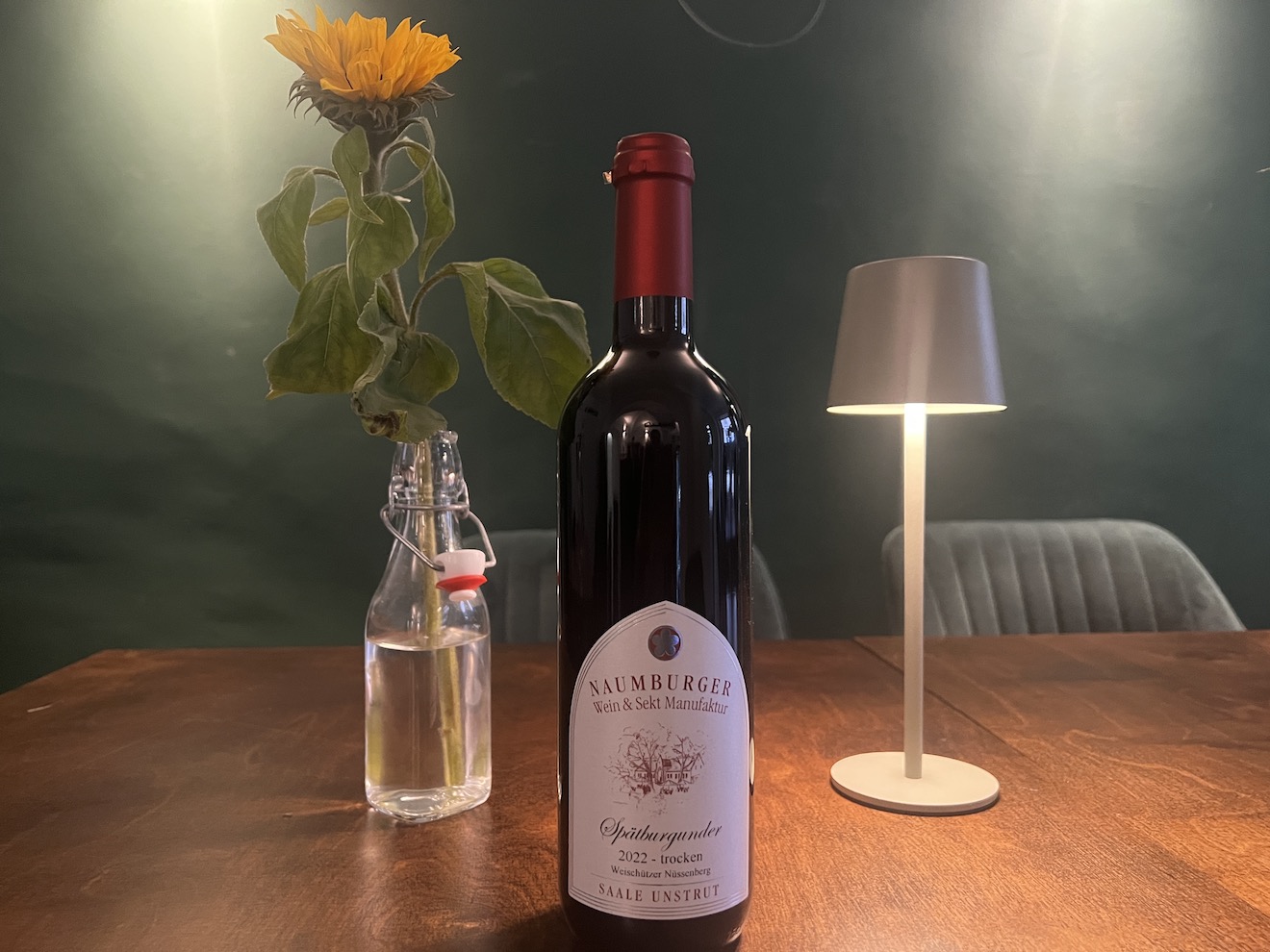 Wine, Wine, Wine
Wine, Wine, Wine
We present wines from our region. These are currently served (come by and see for yourself), drunk up because the guests liked it so much and the wine of the corresponding vintage (this is in the nature of things) could no longer be reordered. Some wines are not served anymore because they were put back, saved, just before they were drunk. And finally, you can read some interesting facts about the wine, the cellar and the pressing process.
₪ ₪ ₪

 2023 Poet Cuveé Werkstück Weimar Winery Winzervereinigung
2023 Poet Cuveé Werkstück Weimar Winery Winzervereinigung
The fruity white Cuvée Poet is characterised by the aroma of red vineyard peaches, crisp gooseberries and a hint of exotic fruit. The white wine has a finely balanced acidity.

 2023 Grauburgunder Muschelkalk Auslese Grober Feetz
2023 Grauburgunder Muschelkalk Auslese Grober Feetz
This white wine is produced by the family winery of Stephanie Grober and Tino Feetz, from the vineyard to their own cellar, bottled and labelled, labour-intensive and entirely by hand. A pleasure in every respect.

 2023 Gutedel Ambrosius Grober Buntsandstein winery Grober Feetz
2023 Gutedel Ambrosius Grober Buntsandstein winery Grober Feetz
This Gutedel (Chasselas) comes from a steep slope, is hand-picked and the vines are rooted in a terroir with a special history.

 2024 Weisser Hey Winery HEY
2024 Weisser Hey Winery HEY
The 2023 vintage was quickly drunk up. Now the Weisse Hey is returning as a German wine.

 2023 Spätburgunder Rosé Winery Weinbauges. 1835
2023 Spätburgunder Rosé Winery Weinbauges. 1835
A dry Spätburgunder (Pinot Noir) rosé, new to the bar.

 2023 Weißburgunder Weinbauges. 1835
2023 Weißburgunder Weinbauges. 1835
A dry Weißburgunder (Pinot Blanc) from the Naumburger Weinbaugesellschaft e. V. since 1835.

 2024 Cuvée Rosé Winery Böhme & Töchter
2024 Cuvée Rosé Winery Böhme & Töchter
After the quickly drunk 2023, the 2024 has now come to us as a German wine of elective affinity. Again off dry.


Cork and screw cap
The two most common and popular types of closure for wine bottles are the cork and the screw cap. Opinions differ on the question of whether a wine is better sealed with a cork or a screw cap.


Tartarte crystals
Most of us have experienced opening what promises to be a phenomenal bottle of wine, only to be surprised by small crystals on the cork or particles suspended in the wine. Don’t panic — those crystals are called tartrates and they are simply a sign of how the wine was made. They are harmless to the wine drinkers and do not affect wine quality.


Kerner
This grape variety was bred in 1929 by August Herold at the State Teaching and Research Centre in Weinsberg. Trollinger was crossed with Riesling. It was named after the Weinsberg poet, doctor and wine lover Justinus Kerner (1786-1862).

 2022 Kerner Auslese (berry selection) sweet Winery Wein- und Sektmanufaktur
2022 Kerner Auslese (berry selection) sweet Winery Wein- und Sektmanufaktur
This Kerner Auslese is a wine with a stimulating interplay of residual sweetness and acidity.

 2023 Weißer Burgunder Winery Pawis
2023 Weißer Burgunder Winery Pawis
This Weißburgunder (Pinot Blanc) bears witness to the terroir of the Saale and Unstrut rivers. It is soft, fruity and reminiscent of stone fruit. Subtle minerality. German Quality Wine Saale-Unstrut.

 2024 Bacchus Winery Pawis
2024 Bacchus Winery Pawis
This Bacchus impresses with its freshness and fruitiness. The winemaker himself likes to call it the Sauvignon Blanc of the north. German Quality Wine Saale-Unstrut.

 2023 Weißburgunder Spätlese Buntsandstein Winery Johannes Beyer
2023 Weißburgunder Spätlese Buntsandstein Winery Johannes Beyer
Dry predicate wine, Karsdorfer Hohe Gräte. A green-pigmented sunny yellow colour in the glass.


Sauvignon blanc
The name Sauvignon Blanc comes from the French words “savage”, meaning wild, and “blanc”, meaning white. For a long time, Bordeaux was considered the probable place of origin of Sauvignon Blanc. The name was first mentioned in writings from the region around 1710. However, the grape variety is actually much older.

 2024 Sauvignon blanc Muschelkalk Winery Johannes Beyer
2024 Sauvignon blanc Muschelkalk Winery Johannes Beyer
German quality wine, light yellow in the glass, a little green bell pepper on the nose, later lychee aromas.

 2024 Silvaner Alte Reben Muschelkalk Winery Johannes Beyer
2024 Silvaner Alte Reben Muschelkalk Winery Johannes Beyer
German quality wine. In the glass, it has a bright yellow colour with green reflections. The nose is reminiscent of a really green pear and hello, we quote the winemaker, ‘ice candy nuances’.


